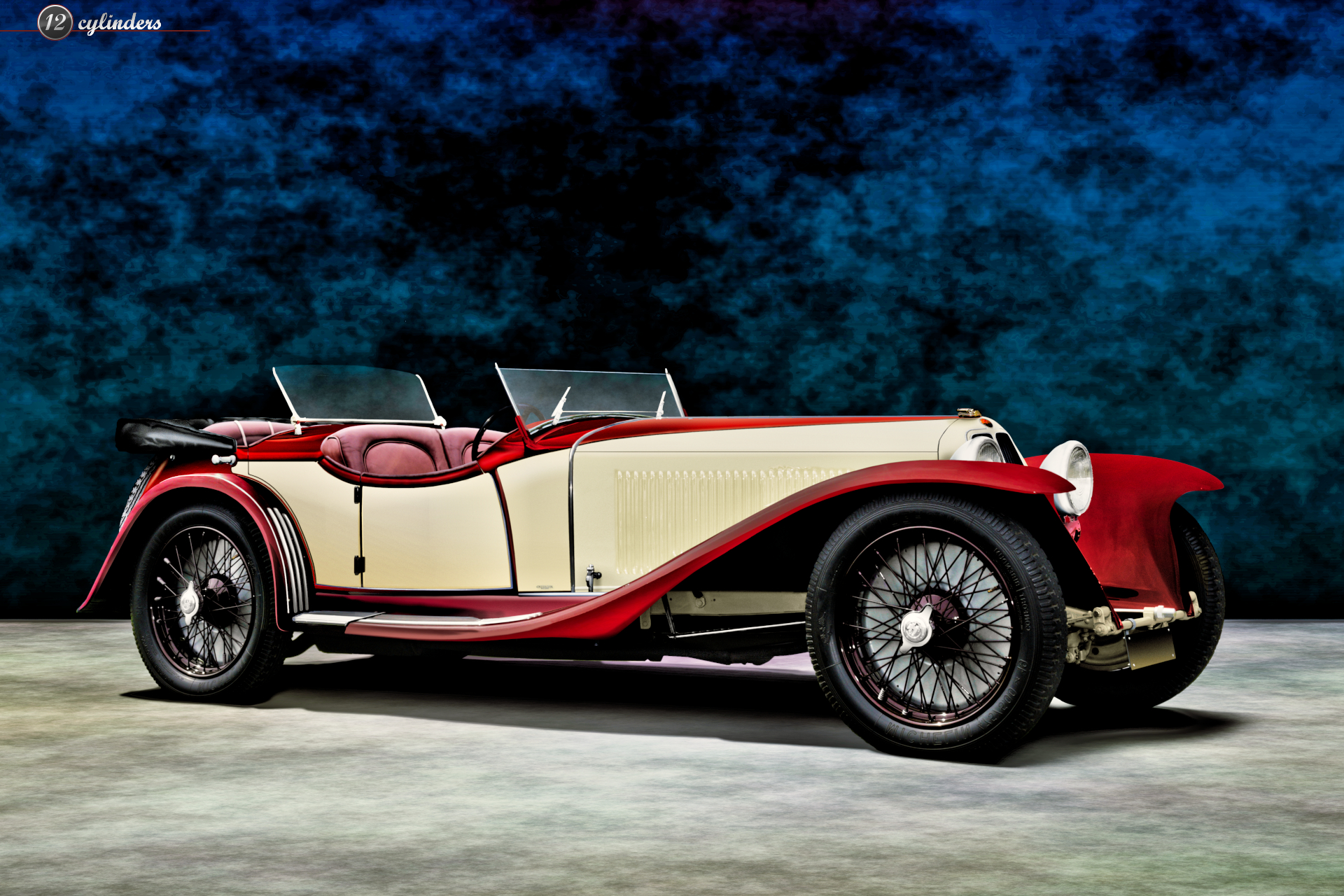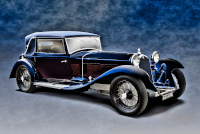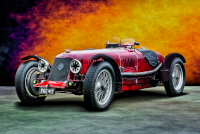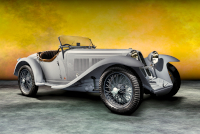Prologue:
The car I've illustrated here no longer exists.
A Maserati that slipped through the cracks of history, we see a few suppositions at play. First, we know the car from a lone photograph dated to 1932 at Villa d'Este. Second, Crump and de la Rive Box list chassis #2521 as a possible touring car built on the 8C 2500 chassis (same as the Tipo 26M), and they note that Maserati built "two 4-seater sports cars" on this platform. So the supposition appended to fact is that at least one 8C Maserati road car emerges in 1932, and this car is perhaps #2521.
For my part, I find the coachwork exceptional, which is reason enough to illustrate what this car might look like if wheeled into a modern studio. The broader context is that these obscure Castagna-bodied 8C examples are the first true road-going Maserati cars. And however many came into existence in the classic era, none survived.
- - - - - - - - - -
► Image Source: Nikon D750 (24.3 MP) illustration finished at 19.4 MP
References:
- Crump, Richard; de la Rive Box, Rob. "Maserati Sports, Racing and GT Cars from 1926" Third Edition, G.T. Foulis & Company for Haynes Publishing Group PLC, Somerset, England. 1992, page 30, 34
- Carrozzieri Italiani: In this same feature, the site includes a photograph of what appears to be a Lancia Dilambda Dual-Cowl Phaeton with coachwork by Viotti. However, they do produce a copy of the Villa d'Este photograph.
- Wikipedia: More background on the Tipo 26M.
The Maserati Road Car Concept
In the early classic era, Alfa Romeo and Bugatti produce successful road car variations with Grand Prix mechanicals. The Maserati brothers are not ignorant of the same potential. For instance, Castagna develop a sample of coachwork styles for the 8C (late Tipo 26M). The factory also draft basic designs for 4C and 8C road cars, a selection of which Crump and de la Rive Box print in their model history. These designs could be optioned (theoretically, at least) as Sport and Gran Sport models, nomenclature that Castagna use in their coachwork styles.
One particular factory design printed by Crump and de la Rive Box depicts a dual-cowl sports tourer intended to be an 8CS of either 2500 or 2800 specification. This drawing could be a later conception, perhaps based on the Castagna design seen here. The factory version includes fully skirted running gear, rear wheel skirts, and a more fully enclosed body. The scallop motif remains, but the cut in the doors is much less curved, the body less trim.
This factory concept also feels less practical. The factory drawings are simple and do not fully convey the concepts that the lines suggest. So while Maserati demonstrate their fondness for road car design, a coachbuilder would mould its own shapes to properly execute the concept in the round.
Castagna, for instance, craft an extraordinary dual-cowl torpedo on this Grand Prix chassis.
For the luxury market, however, Maserati production is far too limited, and their clientele much too focused on racing to invest resources in road car manufacture. The ideas are handy, with plenty of ink put to paper, but by the end of 1932 Maserati become focused on works racing, and these rare road cars become footnotes in the marque's competition history.
The Tipo 26M Dual-Cowl by Castagna
As other sources note, Maserati set aside perhaps two chassis for four-seat sports car coachwork. The second may be the Castagna-bodied berlina known by two photographs taken in 1938, (or that car may be a re-body of this, or another 8C). In any case, not only does Maserati produce a dedicated road car in 1932, but at some stage in the classic era they also produce the first Maserati quattroporte (with no foreknowledge that this configuration will become significant for the marque).
The car depicted here is a rather extraordinary concept. The scale is diminutive compared to an 8C 2300 Alfa Romeo, and with greater power. The 8C 2300 Alfa is an all-around sports car developed for Le Mans, the Mille Miglia, and Grand Prix racing through various chassis adaptions. In contrast, Maserati suit their 8-cylinder car for Grand Prix racing. And in many ways, this approach makes a roadable version much less practical.
If the formula of a lighter, lower, more powerful 8-cylinder Italian sports car sounds attractive, that Maserati do not produce this type of automobile in quantity is perhaps fortunate because the garage does not possess the volume manufacturing capability of its Milanese counterpart. So however fetching this proposition may seem from a driver's perspective, the ownership reality would be little different than that of a specialized Grand Prix works car.
What remains is an aesthetic exercise—extraordinary, for certain, but a true chimera. The car cannot exist; it is too much of two vastly different things.
Motor: 2,495 cc straight 8-cylinder, cast-iron block and head | 65 mm x 94 mm | 5.5:1 compression
Valvetrain: DOHC, 2 valves per cylinder
Aspiration: Weber 55AS1 carburetor, Roots-type supercharger
Power: 185 bhp at 5,500 rpm
Drivetrain: 4-speed gearbox, rear-wheel drive
Front Suspension: semi-elliptic leaf springs, friction dampers
Rear Suspension: live axle, semi-elliptic leaf springs, friction dampers
Architecture: steel ladder-frame chassis, aluminum coachwork by Castagna of Milano
Kerb Weight: approximately 1,000 kg (2,204.6 lbs)
Wheelbase: estimated 2,790 mm (109.84 inches) based on the Sport chassis
Top Speed: 180 km/h (111.8 mph)
Etymology:
In 1926, the Marquis Diego de Sterlich helps Alfieri purchase the remains of Diatto, which gives life to the brothers' independence. That year, Maserati name their first racing automobile the Tipo 26.
Following the 26B (second series, 2 litres), the 26M is the final series of Tipo 26 development (2.5 litres). Although 'M' refers to the 'monoposto' configuration of late Tipo 26 cars, the series is a broad exercise of possibilities. Biposto race cars form part of production, as do a very few select chassis for road use. Among these, the 'Sport' designation is a long-chassis variant suited to sports car use, or road use in the case of this solitary dual-cowl exercise.
The Tipo 26M is also known as the 8C 2500, or 8C 2800 where the motor displacement increases. Crump and de la Rive Box use the 8C 2500 nomenclature, which suggests continuity with the subsequent 8C 3000. However, the latter might be more formally known as the '8C' and nothing more, its displacement an academic matter, except that all of these cars share similar chassis. The Official Maserati history uses the Tipo 26M nomenclature, then transitions directly to the 8C.
The 'Double Phaeton' nomenclature maintains consistency with other references, though the car could be known as a dual-cowl sports tourer. Either is accurate in the coachbuilder's vernacular.
Figures:
Crump and de la Rive Box cite eleven cars built in this final Tipo 26 series, though the number has grown to as many as 14, perhaps accounting for aberrations that peek at us through history.
Regardless of whether chassis #2521 is in fact this Castagna Double Phaeton illustrated here, the car is entirely unique and, as noted, no longer exists.
Dual-Cowl Castagna: A Lesser Known Italian Coachbuilt Style
Among these Italian dual-cowl design exercises, most are much larger chassis, the likes of the Isotta Fraschini Tipo 8A and Lancia Dilambda. To squeeze the same configuration into a low, narrow Grand Prix chassis is a rare trick, (though not exclusive owing to contemporary Le Mans four-place specifications).
The effect is partly English in proportion, with the rear compartment well over the rear axle. The front windscreen sits exceptionally low, (what would be a mere wind deflector on any racing 8C). The door is small, the bonnet long. The rear windscreen sits taller and to the inside of a broad cowl, the glass curved in a gentle transom.
Castagna then use a dashing running gear complement, sharp at the front and mildly swept at the tail. Note that the gentle curve as the front fender sweeps into the running board mirrors the body panel sweep above. The shape of the car through the bulkhead, low-slung door, and hind quarters is complex, but the three sections work in harmony despite the car's small stature.
As we noted earlier, a period Maserati factory drawing of a dual-cowl sports tourer published by Crump and de la Rive Box depicts a similar scallop motif along the bonnet, wrapped over the flanks. I presume the Castagna design shown here is the genesis of that concept. The sweep is deeper on this car and the cowls better integrated within the body. Moreover, the car is immediately recognizable as a Maserati by its proportion and general line. Contrarily, the factory drawing suggests a modernization of this style that never came to be, and does not convey the Maserati identity.
Maserati Revival: Chassis #2521 Illustration
When I first saw the factory drawing of a dual-cowl sports tourer, I thought the concept far-fetched. The simplicity of the drawing partly explains my skepticism, no less the authors' note that, "It is doubtful if the car was ever built."
But even so, finding photographic evidence of the genuine article required a moment to digest what I was seeing. Yes, the car existed, albeit in a dashing style that represents a rare stroke of Castagna mastercraft. And we cannot say this of automobiles very often: Nothing else like it existed. So I felt it would be important to give new life to the design.
In attempting this build, I found myself continually trimming the height and wheelbase; it is a small car that looks grand because of its proportions, not its stature. Thanks to its Grand Prix dimensions, the scale is ergonomically sub-human and nothing like its grand European counterparts. So what would seem at a glance to be a sophisticated Alvis drophead coupe is instead a smaller, lighter, more powerful car.
For the livery, I took inspiration from Simon Moore's Alfa Romeo 8C 2900A, chassis #412007, though the color is much more saturated. (The red umber used on Moore's car is rather similar to the wheels seen here, whereas the Alfa wears black wires.) And while it would be fun to experiment with color combinations, Moore's livery stuck in my mind from the start, and so that is how I drafted the car. The result is at least passable, but more probably worthwhile for the chance to answer that bothersome question of what was the first Maserati road car.
Also note that at Villa d'Este, the car wore a spotlight attached to the upper edge of the front windscreen. I omitted this feature from the illustration.
Last Updated: Mar 26, 2025




